#chooda removal ceremony
Explore tagged Tumblr posts
Text
What Do You Do With Your Chooda After Marriage?

After marriage, many brides wonder what to do with their chooda once its traditional purpose is fulfilled. The chooda, a set of red and white bangles, symbolizes a bride's marital happiness and is typically worn for a specific period, such as 40 days, six months, or even up to a year, depending on family customs.
Can the Chooda Be Removed and Worn Again?
Traditionally, once the chooda is removed, it is not worn again. This belief stems from cultural practices that view the marriage chooda as a unique item meant for the initial phase of marriage. However, some women choose to keep their chooda as a keepsake or repurpose it creatively, such as framing it or turning it into decorative pieces.
Chooda Removal Ceremony
In many cultures, the chooda removal ceremony marks the end of the designated period of wearing it. This ritual, often carried out by family members, is seen as a moment to wish the bride continued happiness and blessings in her married life.
How to Remove Chooda After 40 Days
Removing the chooda after the traditional period can be done with care. It’s typically taken off in a gentle manner, often during the chooda removal ceremony. If you are unsure, seek help from an elder or someone experienced in the tradition to guide you through the process.
Can We Wear Chooda Again?
Generally, once the marriage chooda is removed, it is not worn again in the same form. However, if a bride wishes to revisit that part of her life, she can opt for imitation sets that carry the sentimental value without conflicting with tradition.
What to Do With Chooda After Marriage?
After removing the chooda, many brides choose to keep it as a cherished memento. Some creative ideas include framing it in a shadow box or transforming parts of it into decorative jewelry, ensuring that its sentimental value continues to bring joy.
#cosmetics#what to do with chooda after marriage#can choora be removed and worn again#chooda removal ceremony#how to remove choora after 40 days#can we wear chooda again#marriage chooda
1 note
·
View note
Text
what to do with chooda after marriage
Chooda, the traditional red and white bangles worn by brides in various Indian cultures, holds immense significance. These ornate bangles symbolise a bride’s marital status and the blessings of her family. After the wedding, many brides wonder what to do with their chooda. Should it be preserved, discarded, or worn daily? Here’s a comprehensive guide on what to do with your chooda after marriage.

1. Understanding the Significance
Before deciding what to do with your chooda, it’s essential to appreciate its cultural and emotional significance. Traditionally, chooda is worn for a set period, typically 21 days, after the wedding. It is believed to bring good luck and prosperity to the couple. The chooda also acts as a protective charm for the bride, symbolizing her new life and identity as a married woman.
2. Wearing It for a While
Many brides choose to continue wearing their chooda for some time after the wedding. This practice can be especially meaningful if you’re transitioning into your new life. Wearing the chooda daily can serve as a reminder of your vows and the love shared during the wedding ceremony. It can also be a conversation starter, allowing you to share the stories and traditions behind the chooda with friends and family.
3. Preserving It as a Keepsake
If you prefer not to wear your chooda daily, consider preserving it as a keepsake. Many brides opt to store their chooda in a beautiful box, perhaps alongside other wedding mementos. This preservation allows you to cherish your wedding memories and can even serve as a lovely heirloom to pass down to future generations. When storing, ensure the box is lined with soft fabric to protect the bangles from scratches.
4. Repurposing the Chooda
For those who are creative, repurposing your chooda can be a unique way to keep the spirit of your wedding alive. Some brides turn their chooda into jewelry pieces, such as necklaces or earrings. This transformation allows you to carry a piece of your wedding day with you in a new form. You can also consider using the chooda as decorative elements in your home, incorporating them into art pieces or festive decorations.

5. Rituals and Customs
In some cultures, there are specific rituals related to the chooda post-wedding. For example, some brides participate in a ritual where the chooda is immersed in a sacred river or a ceremonial fire, symbolizing the end of the bridal phase. Understanding and embracing these customs can enhance your connection to your culture and make the transition into married life more meaningful.
6. Sharing with Future Generations
Another thoughtful way to honor your chooda is to share it with your daughters or daughters-in-law when they marry. The act of passing down the chooda symbolizes the continuation of family traditions and can provide a sense of belonging and continuity. Before doing so, consider having a discussion with them about the significance of the chooda and what it represented during your wedding.
7. Consulting Family Traditions
Ultimately, what you choose to do with your chooda should align with your family’s traditions and your personal preferences. Engage with your family members to understand their perspectives and customs regarding the chooda. This discussion can provide valuable insights and strengthen your familial bonds.
Conclusion
Deciding what to do with your chooda after marriage is a deeply personal choice that can reflect your values, creativity, and cultural heritage. Whether you choose to wear it, preserve it, re-purpose it, or pass it down, the chooda will always hold a special place in your heart as a symbol of love, commitment, and new beginnings. Embrace this beautiful part of your wedding journey and make it your own!
1 note
·
View note
Text
Choora Farewell
A Symbolic Farewell: The Choora Removal Ceremony
Understanding Choora
Choora, a traditional bridal adornment, holds significant cultural and symbolic importance in many Indian traditions. It typically consists of red and ivory bangles worn by the bride for a specific period, usually 40 days. This practice is rooted in cultural beliefs and traditions, often symbolizing good luck, fertility, and the transition into married life.
The Significance of the 40-Day Period
The 40-day period is not arbitrary. It's often associated with spiritual and cultural beliefs. Some believe that wearing the choora for this duration brings good fortune and protects the bride from evil influences. Additionally, it might symbolize a period of adjustment and adaptation to the new phase of life.
The Choora Removal Ceremony
The removal of choora is often accompanied by a small ceremony or ritual. This practice varies across different regions and communities, but some common elements include:
Timing: The choora is typically removed on the 41st day after the wedding.
Ceremony: A simple ceremony might involve prayers or blessings.
Removal: The choora is usually removed by a close female relative, such as a sister-in-law.
Gift Exchange: In some traditions, the bride may give a gift to the person who removes the choora.
Cultural Variations
The specific rituals and traditions associated with choora removal can vary significantly across different regions and communities in India. For instance, in some regions, the choora may be removed by the bride's mother or grandmother. In others, a priest or pandit may be involved in the ceremony.
Symbolic Significance
The choora removal ceremony holds significant symbolic meaning. It marks the end of a phase of life and the beginning of another. The choora, which has been a constant companion during the initial days of marriage, is now removed, symbolizing a transition from the single life to married life.
Post-Choora Removal Traditions
After the choora is removed, some brides choose to store it as a keepsake. Others may donate it to a temple or river. The choice often depends on personal beliefs and family traditions. In some cultures, the choora may be buried or discarded in a specific manner.
Modern Interpretations
With changing times, more women are opting to wear choora beyond the traditional 40-day period. This reflects a shift in cultural attitudes and a desire to personalize traditions. While the traditional significance of the choora remains intact, modern interpretations allow women to express their individuality and preferences.
Conclusion
The chooda removal ceremony is a significant event in many Indian weddings. It marks the end of a tradition that has been passed down through generations. While the specific practices may vary, the underlying symbolism and cultural significance remain consistent. The ceremony is a time for reflection, gratitude, and the anticipation of a new chapter in life.
#what to do with chooda after marriage#can choora be removed and worn again#chooda removal ceremony#how to remove choora after 40 days#can we wear chooda again#marriage chooda
1 note
·
View note
Text
Choora Ceremony Significance: A Timeless Tradition
The choora ceremony holds a deep-rooted significance in Indian weddings, particularly in North Indian cultures, symbolizing blessings, prosperity, and the bride’s transition into married life. The choora, a set of red and white bangles, plays an integral role in this tradition, making it a cherished and meaningful part of a bride’s journey.

What is a Chooda?
A chooda, or choora, is a set of usually 21 or 51 bangles, traditionally made of ivory but now commonly crafted in plastic or other materials for practicality. These bangles are red and white in color, often adorned with intricate designs and embellishments. They symbolize prosperity, good fortune, and the bride’s married status.
Why Do Brides Wear Chooda?
The practice of wearing a chooda is believed to bring good luck and happiness to the bride’s new life. It is considered auspicious and is meant to ensure a prosperous and harmonious marriage. The red color signifies energy, love, and passion, while white represents purity and new beginnings.
Chooda Ceremony: A Joyous Occasion
The choora ceremony is performed by the bride’s maternal uncle (mama) and aunt (mami), who gift the choora to the bride as a blessing. This ritual typically takes place on the morning of the wedding day or a day prior. During the ceremony, the bangles are purified with milk and rose water and then placed on the bride’s wrists amidst prayers and blessings from elders.
How Long Do Brides Wear Chooda?
Traditionally, a bride wears her chooda for a minimum of 40 days to a maximum of a year after the wedding. The specific duration varies based on regional customs and personal preferences. Some brides continue wearing them for their symbolic value, while others may remove them earlier for comfort or practicality.
Why Do Indian Brides Wear Bangles After the Wedding?
Wearing bangles after marriage is a longstanding tradition in Indian culture. Beyond their ornamental value, bangles represent a married woman’s commitment, vitality, and prosperity. The gentle tinkling of bangles is said to bring positivity and harmony into the household.
Modern Trends in Chooda Wearing
While traditional customs are still widely followed, modern brides often adapt the practice to suit their lifestyles. Some choose to wear lighter or less elaborate chooda sets, while others opt for designs that blend tradition with contemporary aesthetics. Additionally, chooda colors and styles have diversified, offering brides more choices to express their individuality.
Conclusion
The chooda ceremony is a vibrant and emotional tradition that celebrates the bride’s new beginning. Whether worn for weeks or months, the chooda serves as a beautiful reminder of the blessings and love bestowed upon her as she embarks on her marital journey. In essence, the chooda is more than just a piece of jewelry—it’s a timeless emblem of culture, family, and hope.
0 notes
Text
What to Do with Chooda After Marriage
After marriage, the chooda holds deep cultural significance and serves as a cherished reminder of the wedding day. Traditionally, brides wear these red and white bangles for a specific period, symbolizing their marital status and new beginnings. Here are several thoughtful ways to honor this tradition.
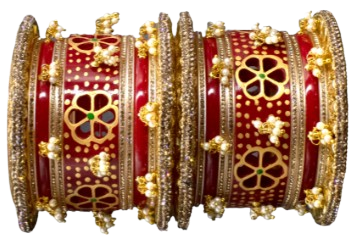
Firstly, many brides choose to continue wearing the chooda for a few months post-wedding. This practice allows them to celebrate their new role and identity. Once this period is over, a ceremonial removal can take place, often accompanied by family and friends, making it a memorable occasion.
For those who prefer to keep the chooda as a memento, storing it in a special box or pouch can be a lovely way to preserve the memory. Some brides creatively repurpose the bangles into new jewelry, such as a necklace or bracelet, allowing them to wear a piece of their wedding day in everyday life.
Passing down the chooda as a family heirloom is another meaningful option. This tradition connects generations, as daughters or daughters-in-law may inherit the chooda, embodying the family's history and love.
Finally, displaying the chooda in a decorative box at home can serve as a beautiful reminder of the commitment made on the wedding day. Whether worn, stored, repurposed, or passed down, the chooda remains a powerful symbol of love and unity long after the ceremony concludes.
#What to Do with Chooda After Marriage#Chooda Traditions Post-Wedding#Chooda Care After Marriage#Storing Chooda After Marriage#Chooda Significance After Wedding#wedding chuda
1 note
·
View note
Text
Rajasthani Bridal Chooda: Symbolism and Styling Tips

Introduction to Bridal Chooda
Definition and Significance
The bridal chooda is a traditional ornament worn by brides in Rajasthan, symbolizing marital status and cultural heritage.
Composed of a set of bangles, typically made from ivory, plastic, or glass, the chooda is an essential part of Rajasthani bridal attire.
Cultural Context
The chooda reflects the rich cultural traditions of Rajasthan, intertwined with local customs and rituals.
Traditionally, the chooda is gifted to the bride by her maternal uncle, emphasizing familial bonds.
Historical Background
Origin and Evolution
Tracing the origins of chooda in Rajasthan, its evolution from traditional materials to contemporary designs.
Influence of Mughal and Rajputana aesthetics on the design of bridal chooda.
Symbolism of Colors and Designs
Colors like red and white symbolize prosperity and purity, commonly used in bridal chooda.
Traditional designs often incorporate intricate motifs, floral patterns, and gold embellishments.
Craftsmanship and Materials
Artisans and Crafting Techniques
Highlighting the artisans behind these exquisite pieces, focusing on the skills passed down through generations.
Techniques involved in crafting chooda, including engraving, painting, and the use of semi-precious stones.
Materials Used
Description of materials traditionally used, such as ivory, lacquer, and glass, and their significance.
The shift to environmentally friendly materials in modern designs.
Rituals and Traditions
The Ceremony of Chooda Wearing
The rituals involved in the chooda ceremony, including the blessings from elders and the significance of wearing the chooda after marriage.
How the chooda is removed after a specific period, marking a transition in the bride's life.
Regional Variations
Differences in chooda styles and rituals across various regions of Rajasthan, showcasing the diversity within the tradition.
Influence of local customs and festivities on the design and significance of chooda.
Modern Adaptations
Contemporary Designs and Trends
How modern brides are incorporating chooda into their wedding attire, blending tradition with contemporary fashion.
Popular trends, including customization, incorporation of gemstones, and modern color palettes.
Influence of Social Media
The role of platforms like Instagram and Pinterest in popularizing bridal chooda designs and styles among brides-to-be.
Influencers and designers who are reshaping the perceptions around traditional bridal jewelry.
Styling Tips
Complementing Bridal Attire
Guidance on how to style bridal chooda with various outfits, including lehengas, sarees, and fusion wear.
Tips on coordinating colors and materials to create a harmonious look.
Accessorizing with Chooda
Suggestions on how to pair chooda with other traditional jewelry pieces, such as necklaces, earrings, and maang tikka.
Importance of balance in jewelry choices to enhance the overall bridal appearance.
Conclusion
The Timelessness of Bridal Chooda
Reflecting on the enduring legacy of the bridal chooda in Rajasthani culture and its significance for future generations.
Encouragement for brides to embrace their heritage through the beauty of traditional adornments.
#Rajasthani Chooda Designs#Traditional Rajasthani Chooda#Bridal Chooda from Rajasthan#Rajasthani Chooda for Weddings#Authentic Rajasthani Chooda
0 notes
Text
Punjabi Pre-Wedding Traditions

Punjabi weddings have always been the most famous and known for fun-filled functions. One can find a display of different traditions and the jolly nature filled with the dancer in themselves. Everyone has a perception about Punjabi weddings that they are loud and extravagant and somewhere it is the truth but does not forget that they are fun-loving as well. You will never find a single moment becoming dull. Moreover, famous Bollywood films like Dilwale Dulhaniya Le Jayenge, Mere Dad ki Maruti, and many others have projected Punjabi Hindu Weddings in a way that today; Punjabi weddings are now known as synonyms for Indian Weddings. No, we are not saying that it is true for everyone but this is how the world sees it. To be very honest on our point Punjabis have always been very particular about upholding their traditions and old wedding rituals. Here we have almost all the pre-wedding functions that can be witnessed in a Punjabi wedding.
Roka Ceremony
This is the very first ritual in Punjabi wedding in which the wedding is fixed between two people. In this Bride’s family visits the family home of the groom with a lot of gifts. Usually, the bride is not present that day. This visit is now reciprocated by the groom’s family just like the bride’s family did and the couple is now considered to be officially engaged and they are made to sit together so everyone in the family can shower their blessings and gifts also called as shagun aur sagan. They both are also supposed to eat laddus. This function has always been a little low key and nowadays Roka and thaka are kept on the same day, basically to fix the dates. And most important this function is started with a small or ardaas.
Chunni Ceremony
Chunni ceremony marks the official engagement of the to-be-weds. Usually, the family members of the groom visit the family of the bride with gifts. A red-colored outfit like a sari or a lehenga-choli has gifted a headscarf called chunni.
Sagai and Engagement Ceremony
On the day when the chunni chadhai ceremony is taking place, that very day sagaai or engagement ceremony takes place. The bride and the groom exchange their rings with each other in the auspicious presence of their family and friends. Not only this they are now getting accepted officially by the opposite families. People also consider the exchange of rings as the final mark of acceptance of the bride welcoming them in their lives and family.
Mehendi Ceremony
Mehendi is an essential part of almost all Indian weddings, which cannot be missed. It is that part of the Indian weddings, that every Indian woman dreams of and is very excited for it. Mehendi artists are called to the house of the bride a day or two before the wedding day. Beautiful henna designs are made on the bride’s hands and feet, other girls and ladies who are part of the ceremony also get Mehendi done on their hands. The main thing that is kept in mind is no one else than the bride shall get the most beautiful design made.
Sangeet Ceremony
Most of the time ladies sangeet is kept on the same day. In this, ceremony ladies close to the bride’s family sing and dance together making the day more memorable. It can also be called a musical extravaganza. It is the most amazing pre-wedding ritual, as everyone sings and dances around the bride, teasing the bride about her new wedding life. This ceremony is mostly held in the evening, so food is the main part of it somehow.
Kangana Bandhana Ceremony
Kangana bandhna is the first ritual that is performed on the morning of the wedding day. A sacred thread is also known as mouli is tied on the wrist of the bride and the groom separately at their respective homes. This mouli is tied as it is considered to be a good-luck charm and should not be removed until it falls off.
Chooda Chadana Ceremony
Chooda chadana is a ceremony that is followed by the Kangana bandhana ceremony. A havan or sacred fire is placed around that fire all the elderly males from the bride’s side sit around the fire. Bride’s maternal father or mama plays a vital role by taking the main part in the havan. After that the maternal uncle or mama gift the bride-to-be a set of 21 bangles of red/maroon and white/ivory in color. The bangles are then purified in a liquid mixture containing milk and rose petals. Then mama has to put the bangles on the wrist of the bride but one has to take care that the head and hands are covered as the bride is not supposed to see the bangles at the time when it is put on her wrists. Flower petals are showered on the bride-to-be as a part of holy rituals. It is expected that the bride should wear those bangles for at least a time period of 40-45 days.
Kalide Ceremony
The bride is made to be seated facing four lamps or diyas. This ceremony is performed on the morning of the wedding. This is an old ritual that is also common amongst other Indian weddings as well. The women of the house then apply a paste of turmeric (Haldi), sandalwood, rosewater, and mustard oil on the visible parts of the bride’s body. It is believed that this paste acts like a scrub or cleansing agent, that gives shine and glow to the bride’s face. The same ritual is performed at the house of the groom. This ceremony is full-filled with fun and lots of laughter.
0 notes
Text
India is a vast country with different religions, traditions, faith and values and so does the Indian weddings are full of traditions, rituals which hold religious as well as emotional values to each and every function held on weddings.
And from many traditions and customs, there is one most important ritual in Sikh/ Punjabi bride known as “Chooda and kalire rasam”
Both these ceremonies are held on the morning of the wedding day at the bride’s place.
What is a Chooda?
Chooda means a set of bangles, traditionally means a set of 21 bangles in red and white/ ivory. Earlier chooda was made with haathidaant (elephant tusks) but now they are made from plastic.
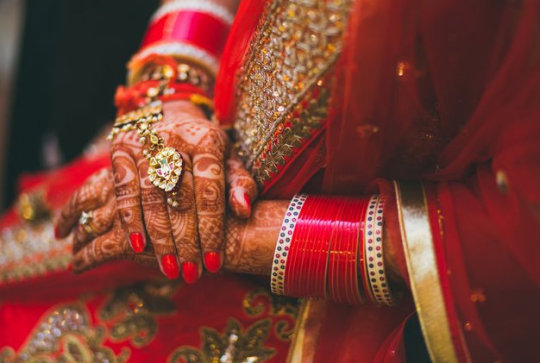
Why it is worn??
Chooda is said to bring good luck for the newlyweds. Also, red is a very important colour for a married woman in India as it strengthens the bond between a couple. Fertility and prosperity are also associated with the chooda, and it is worn for a minimum period of 40 days and maximum for 1.5 years after the wedding.
Like in Hindu weddings bride is supposed to wear “Mangalsutra” & “Sindoor” for his husband sakes, and also a sign of a married woman likewise Sikh / Punjabi bride wears “CHOODA” as in Sikhism married women do not wear “Sindoor” or “mangalsutra” but in some Punjabi traditions they do wear.

When it is worn and by whom?
It is worn on the morning of a wedding day. The chooda is put on a bride’s wrist by the mama “Maternal Uncle”.
In some places, the bride is not allowed to see her chooda and sits with her eyes clothes. They say if you see your chooda before the wedding it is inauspicious. So after the chooda is put, it is covered with a cloth.

Chooda Rasam/Ritual
On the wedding morning, after bride took her bath known as ” Khaare Laana”, the chooda ceremony will be performed. The chooda is put into “Kachhi Lassi” ( mixing milk and water together), yes not only milk but milk and water.

Yes, It is worn after the bath, final bath of a bride to be in her own home as after this she will be a married woman. So, after putting the chooda into a bowl of “kachhi Lassi”, the maternal uncle will start putting the chooda on a bride to be wrist and following, maternal uncle’s wife and then the brothers can perform this ritual.
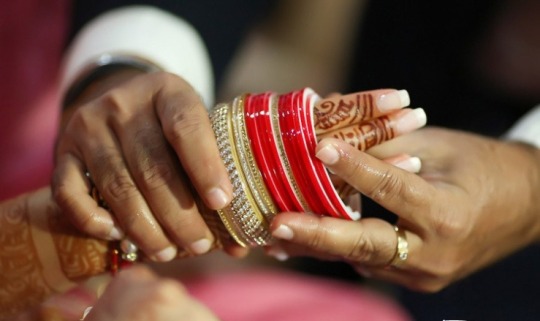
Chooda comes in “Nanki Shakk” ( Gifts from mom’s side Family). In Sikh Wedding, Bridal wear and Chooda is given by them.
Pro Tip: When you put Chooda into kachhi, please do not remove the thread and mix into that mixture, As chooda is ” small in size from the front and larger from the back”, and if you mix it, possibilities of wearing it wrong. So, make sure you do not cut the thread and if you do, there are numbers on the inside of chooda, put it according to the numbers.
There is a variety of chooda, from colours to design to anything you name and it’s in the market.
Nowadays brides can select colours like pink, maroon, orange, white to match their chooda to their bridal outfit.
The number of bangles has now been replaced by sets so you can opt for a single, double or triple set. The designs traditionally had red dots on the white bangles but now flashy rhinestones and Swarovski are also used.
Customised Chooda, yes! you heard it right you can customise the chooda like * You can get it with bride and grooms name on it. * Pictures of bride and groom etc.
In Punjabi tradition, A puja or havan is usually organised during the chooda ceremony. The bangles are first purified with milk and rose petals. Before it is put on the bride’s wrist by her maternal uncle, all the close relatives touch the chooda as a mark of their blessings. After that, the wrist is covered with a white cloth, as the bride cannot see the chooda until the time of the wedding ceremonies.
What not to do??
You can not change or remove the “Chooda” once it wore at least for minimum 40 days.
You cannot remove it by your own, there is a small ritual called ” Chooda wadhana” (Removal of chooda).Chooda Wadhana:Bride’s sister in law (husband’s sister) can only remove the Chooda and then some gifts have been given to her by a bride, it can be anything.And if a bride wants to wear it for a longer time, Sister in law will remove only two bangles from each hand and put it back on her hand.Note: Make sure you do not remove all bangles and only two has to be removed and put it back if a bride wants to wear it as it is. If all bangles are out you cannot wear it back.

Why you cannot remove or change it?
A bride wore it for a husband, and this ritual is performed by bride’s maternal uncle. and it held an emotional as well a belief that it is “worn for husband”. It is a sign of Married Women.
Kalire
Kalire are umbrella shaped hangings which were earlier made of silver or dry coconut and makhana that are encrusted with dried beetle nuts and dry fruits.The significance is to provide good wishes to the bride and to remind her of her cousins and friends whom she is going to leave behind when she gets married. Also, the coconut-shaped of the kalire is symbolic that she never runs out of food in the new home, while the metal symbolises wealth and prosperity But now the modern kaliras are made of metal and studded with rhinestones.

When it is worn & whom?
These are worn after the chooda ceremony when the bride is all dressed up in her bridal wear. Kaleere are gifted by Bride’s sisters, friends and close relatives
Yes, worn after when the bride is all dressed up so the kaleere don’t get tangled.
After the kalire are tied, a bride makes all her unmarried friends and she shakes her hands on their heads. It is believed that if any part or the kalire fall on the head of any girl she will get married soon.
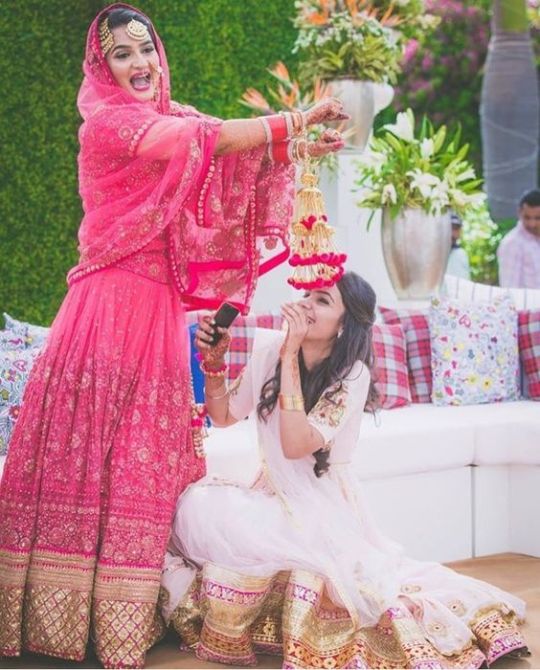
Often there are dried beetle nuts, dry fruits and coconut encrusted on the kalire. These are available in various designs and sizes, and one can pick according to their choice.
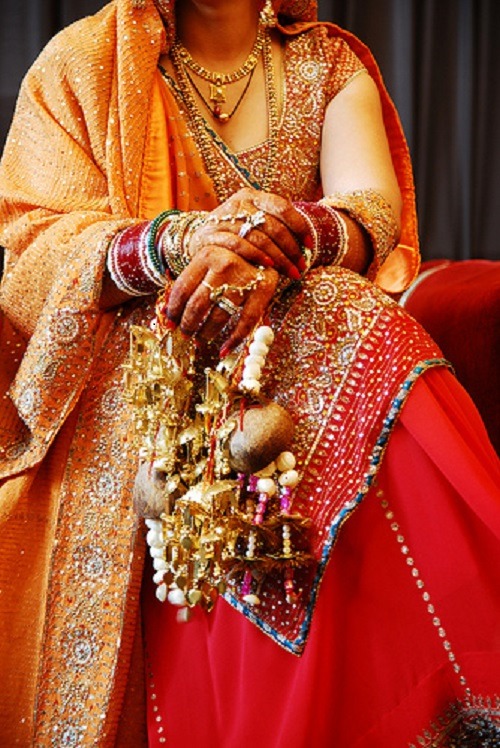
What not to do?
You cannot remove it once it is worn until you reached your new home ( inlaw ) house.
You cannot remove it your own, Sister in law (Husband sister) will do this favour.
What to do with them?
You can save them in their box or also use it as a decor in the house.
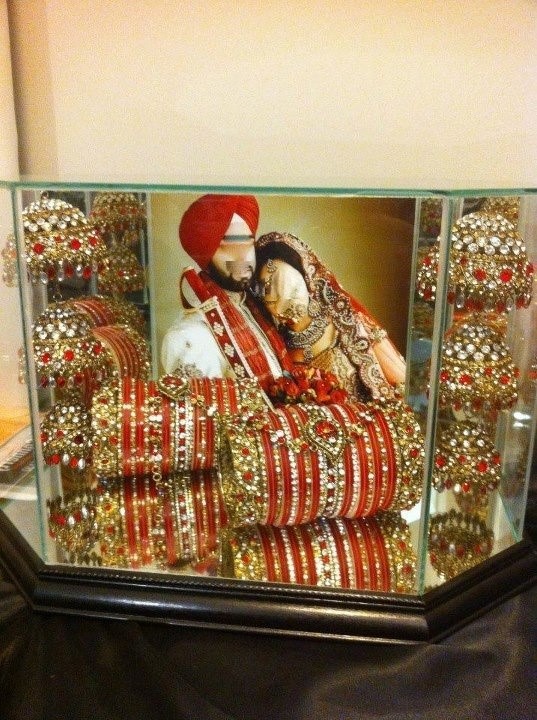
XOXO PC
Significance Of Chooda And Kalire India is a vast country with different religions, traditions, faith and values and so does the Indian weddings are full of traditions, rituals which hold religious as well as emotional values to each and every function held on weddings.
0 notes
Text
Make a glam quotient with your traditional wedding chura
The splendor and the colorfulness of an Indian bridal ceremony can never be matched. What makes Indian weddings more than an event are the emotional, colorful and various rituals with bangles jewelry that make every single guest dazzled and leave many teary-eyes.
How Chura can be defined?
One such essential ritual that is historically part of a Punjabi wedding ceremony is the wedding chura and kalire rite. Chooda or Chura is bangles set and kalire are the exquisite add-ons that hang from the bangles. Designed mostly in white and red, numerous brides today switch the red bangles for different hues. But, the bridal chura is commonly made only from the combination of two colors.
The emotional ceremony of Chura
The Chura is worn in a ceremony held on the morning of the wedding. The paternal uncle and aunt present the Chura for the bride and wear it on her hand. Kalire is an umbrella fashioned accessory that gets hung on the bridal chura. Generally, the sisters and friends of the bride tie the kalire on ladies bangles. The bride wears it for more than a month. After a month, the husband performs a ritual in which he removes the Punjabi chuda for her.
Importance of Chura for new brides
While it is a part of a Punjabi wedding, this ritual is now practiced by various other communities. The bridal bangles are assumed to strengthen the relationship between the couple, and the shade red indicates prosperity and fertility.
The kaleere is a reminder of the soft love and care a bride has acquired from her pals and own family, as she embarks on a brand new journey. The bridal chura is now available in various alternatives: colors, textures, patterns, materials, whatever you like you can get it.
Take a look at the latest chura bangles design and styles that has been getting popular among most of the brides recently.
1) Embellish with the stones of Kundan
Now, add a few charm and glitter on your conventional Chura by way of choosing ones adorned with Kundan stones. Those look good on images, and the stones are certain to match the flicker of joy in your eye.
2) Customized Chura with the couples name
There is something to be said for the beauty of customized bangles that make them unique from others. Now, proclaim your new marital status by means of carrying a Punjabi Chura churi together with your name engraved on it.
3) Chura with a theme
How about deciding a specific theme for your bangles? You’ll find several ones like lamps, peacocks on them. Pick the one that you like and make it look classy with your outfit.
4) Make it look glamorous with gold
Add an exquisite gold plated bangles with stones along with the Chura for it to look unique. The idea will make the Chura look elegant and classy.
Conclusion
Latest Chura design offers a lot of freedom as well as flexibility to the newly-wed brides. Flaunt your Chura proudly as the new bride.
0 notes
Text
The Meaning of Chooda: Symbolism and Cultural Significance

Chooda, a term deeply embedded in Indian bridal traditions, refers to the vibrant set of bangles worn by brides, particularly in northern regions like Punjab, Rajasthan, and Haryana. These intricately crafted bangles are not merely decorative pieces; they carry profound cultural significance and symbolize various aspects of a woman’s journey into married life.
Cultural Significance
The chooda is traditionally gifted to the bride by her maternal uncle or aunt, marking a significant moment in the wedding ceremony. This gesture signifies the family's blessings for her new life. The act of wearing chooda represents the transition from maidenhood to womanhood, embodying the hope and joy associated with marriage. It is believed that the chooda brings prosperity and happiness to the bride's new home, reinforcing her role as a bearer of good fortune.
Symbolism of Colors
The colors of the chooda hold particular meanings in the context of marriage. Red, a predominant color, symbolizes love, passion, and auspiciousness. Green is often included as well, representing fertility and prosperity. The combination of these colors is not just visually striking but also deeply symbolic, reflecting the values and expectations placed upon married women in Indian society.
Ritualistic Importance
Wearing the chooda is accompanied by specific rituals. Traditionally, the bride must wear the chooda for a designated period after the wedding, often extending from a few weeks to several months. During this time, she is expected to maintain them intact as a sign of her commitment to her marriage. Breaking or removing the chooda prematurely is seen as inauspicious, as it symbolizes the disruption of marital harmony.
Craftsmanship and Artistry
The artistry behind Rajasthani chooda designs is remarkable. Made from glass or metal, these bangles are adorned with intricate engravings, mirror work, and colorful embellishments. Artisans in Rajasthan and surrounding regions employ traditional techniques that have been passed down through generations, creating pieces that are both beautiful and unique. Each bangle is often hand-painted or embellished with delicate patterns, showcasing the craftsmanship involved in their creation.
Modern Interpretations
In recent years, the chooda has evolved to include modern interpretations, incorporating contemporary designs while maintaining its traditional roots. Many brides now opt for fusion styles that blend traditional elements with modern aesthetics, such as geometric patterns or mixed materials. This evolution allows the chooda to remain relevant in today’s fashion landscape, appealing to younger generations who wish to honor their heritage while expressing their individuality.
Wearing Chooda Beyond Weddings
While the chooda is primarily associated with weddings, its appeal has expanded beyond the bridal context. Women of all ages now wear choodas during festivals, celebrations, or casual gatherings, using them as a means of self-expression and style. Stacking different sets of choodas has become a trendy fashion statement, allowing individuals to mix and match colors and designs for a personalized look.
Conclusion
In essence, the chooda is a rich tapestry of meaning, culture, and artistry. It is not merely an accessory but a symbol of love, commitment, and the joy of marital life. Each set of chooda tells a story, connecting generations of women to their cultural roots while allowing them to express their unique style. The enduring significance of the chooda reflects the values and traditions that shape relationships in Indian society, making it a cherished element of a bride's ensemble and a beautiful reminder of the journey of marriage.
0 notes